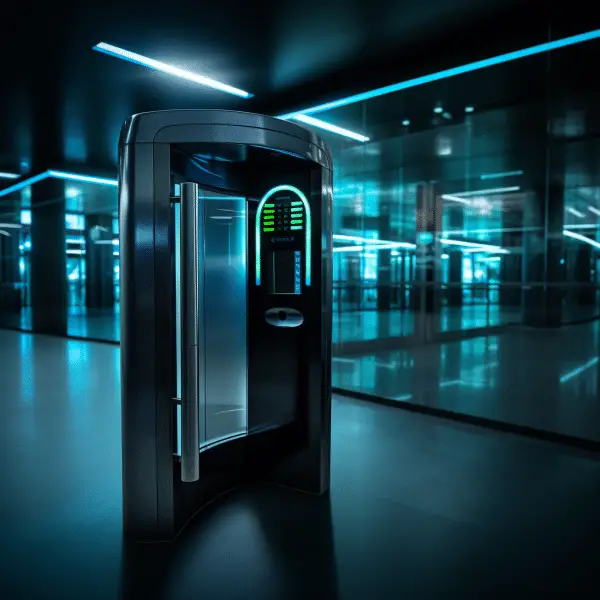It might need to be connected to other authentication systems, but it might be easy to set up.Access control and identity management are two crucial components of a comprehensive security protocol for businesses. Access control refers to the process of regulating and controlling who has permission to access certain resources or systems within an organization. Identity management, on the other hand, pertains to the administration and oversight of user identities and their associated permissions and privileges. Together, access control and identity management work to enhance security, prevent unauthorized access, and protect sensitive data.
Key Takeaways:
- Access control and identity management are essential for maintaining the security of a business’s digital infrastructure.
- Access control regulates who can access specific resources, while identity management focuses on managing user identities and their permissions.
- Integration of access control and identity management systems offers enhanced security and streamlined processes.
- Best practices for access control and identity management include multi-factor authentication, regular reviews and updates of user permissions, and strong password policies.
- Emerging trends in this field include Zero Trust security architectures and passwordless authentication methods.
The Importance of Access Control
Access control plays a vital role in maintaining the security of a business’s digital infrastructure. By implementing access control measures, organizations can ensure that only authorized individuals have the ability to access sensitive information and resources. Access control systems can involve various authentication methods, such as passwords, biometrics, or smart cards, to verify user identities.
Additionally, access control allows organizations to assign specific permissions and privileges to users, granting them access to relevant resources based on their roles and responsibilities. This helps prevent unauthorized access and ensures that sensitive data is only accessible to those who need it. By managing and controlling user permissions, access control enhances security and mitigates the risk of data breaches or internal threats.
“Access control is a fundamental pillar of a robust security strategy. By implementing strict access control measures, businesses can limit the risk of unauthorized access and protect sensitive data from potential threats.”
Moreover, access control provides organizations with better visibility and control over user activities within their systems. Comprehensive access control systems can generate audit logs, allowing organizations to track and monitor user actions, detect any suspicious activity, and take appropriate measures in a timely manner. This not only enhances security but also helps organizations meet compliance requirements and industry regulations.
| Benefits of Access Control |
|---|
| Enhanced security by preventing unauthorized access |
| Control over user permissions and privileges |
| Improved compliance with security regulations |
| Better visibility and monitoring of user activities |
| Protection of sensitive data |
The Significance of Identity Management
Identity control is a crucial component of modern company operations. It maintains and regulates user identities in corporate computer systems, ensuring that only individuals with permission can use specific tools and take specific actions. Identity management requires robust authentication techniques to ensure users are who they claim to be, assign them unique IDs, and maintain track of their profiles and login information. Employing identity management solutions allows companies to create a unified platform that streamlines access control and boosts security in general.
One of the key components of identity management is authentication, which ensures that users are who they claim to be. Authentication methods can range from traditional passwords to more advanced techniques such as biometrics or smart cards. By implementing strong authentication protocols, organizations can strengthen the security of their systems and protect sensitive data.
Furthermore, identity management enables businesses to manage user permissions and privileges effectively. By assigning specific roles and responsibilities to users, organizations can control access to different resources and ensure that sensitive information is only available to those who need it. This helps protect against unauthorized access and reduces the risk of data breaches.
Benefits of Effective Identity Management:
Better security: Using identity management systems can help businesses make their security much better and keep hackers from getting to their digital assets.
Compliance is improved because identity management helps businesses follow security rules and industry norms, which makes sure that data protection needs are met.
Simplified processes: centralized identity management systems make it easier to add and remove users, as well as manage access rights and make changes to permissions as required.
Effective use of resources: Identity management makes sure that resources are used correctly by giving users clear jobs and responsibilities. This increases productivity and efficiency.
Effective identity management is essential for businesses to protect their systems, data, and sensitive information. By implementing robust authentication processes and centralized identity management systems, organizations can strengthen their security protocols and ensure that only authorized individuals have access to valuable resources. This not only minimizes the risk of data breaches but also enables businesses to comply with security regulations and industry standards. As the digital landscape continues to evolve, the significance of identity management will only grow, making it a crucial aspect of any comprehensive security strategy.
| Benefits of Effective Identity Management | |
|---|---|
| Enhanced security | Identity management systems significantly enhance security protocols, protecting digital assets from unauthorized access. |
| Improved compliance | Identity management ensures compliance with security regulations and industry standards, meeting data protection requirements. |
| Streamlined processes | Centralized identity management simplifies user onboarding and offboarding processes, facilitating access rights management. |
| Efficient resource allocation | Identity management assigns roles and responsibilities to users, optimizing resource allocation and productivity. |
The Benefits of Access Control Identity Management Integration
Businesses can get a lot out of combining their access control and identity management tools, such as better security and easier operations. By putting these two parts together, businesses can set up a smooth and effective way to manage user names and restrict access to resources.
One of the key advantages of integration is the ability to achieve enhanced security. By integrating access control and identity management, businesses can establish a centralized system for managing user permissions and access rights. This allows for better visibility and control over user privileges, ensuring that only authorized individuals can access sensitive data. With a comprehensive access control identity management integration, organizations can minimize the risk of unauthorized access and data breaches.
In addition to enhanced security, integration also leads to streamlined processes. By integrating access control and identity management systems, organizations can simplify user onboarding and offboarding. Access rights and user profiles can be easily managed and adjusted, saving time and effort for IT administrators. Furthermore, integration enables organizations to ensure compliance with security regulations and industry standards more efficiently, as access control measures and identity management protocols are seamlessly aligned.
The Benefits of Access Control Identity Management Integration:
- Enhanced security through centralized user permissions and access control.
- Streamlined user onboarding and offboarding processes.
- Efficient compliance with security regulations and industry standards.
| Benefits | Description |
|---|---|
| Enhanced Security | A centralized system for managing user permissions and access rights ensures that only authorized individuals can access sensitive data. |
| Streamlined Processes | Integration simplifies user onboarding and offboarding processes, saving time and effort for IT administrators. |
| Efficient Compliance | Integration ensures efficient compliance with security regulations and industry standards, as access control measures and identity management protocols are aligned. |
Best Practices for Access Control Identity Management
Implementing best practices for access control and identity management is crucial for maintaining robust data security and protecting sensitive information. By following these practices, businesses can enhance their security protocols and prevent unauthorized access to their systems and resources.
Multi-Factor Authentication
One of the key best practices for access control and identity management is the implementation of multi-factor authentication (MFA). MFA adds an extra layer of security by requiring users to provide multiple forms of verification before gaining access to sensitive information. This can include something the user knows (such as a password), something the user possesses (such as a security token), or something the user is (such as biometric data). By combining these factors, organizations can significantly reduce the risk of unauthorized access.
Regular Review of User Permissions
Another important best practice is the regular review and update of user permissions. It is essential to conduct periodic audits to ensure that user access rights are accurate and up to date. This includes removing permissions for employees who have left the organization or changed roles, as well as granting new permissions for employees who require access to additional resources. By regularly reviewing user permissions, organizations can prevent unauthorized access and maintain a secure environment.
“Implementing best practices for access control and identity management is a critical step in safeguarding sensitive data and preventing security breaches.” – Security Expert
Regular Training and Education
Another important best practice in access control and identity management is to educate and train workers on a regular basis. It is important to make sure that all workers know the security rules and know what could happen if someone gets in without permission. By giving employees ongoing training, companies can give them the tools they need to make smart choices and help keep the workplace safe. Data security can also be improved by teaching workers how important it is to use strong passwords and secure authentication protocols.
| Best Practices | Benefits |
|---|---|
| Implement multi-factor authentication | Enhanced security and reduced risk of unauthorized access |
| Regularly review and update user permissions | Prevention of unauthorized access and maintenance of a secure environment |
| Provide regular training and education | Empower employees to make informed decisions and contribute to data security |
Emerging Trends in Access Control Identity Management
Access control and identity management technologies are constantly evolving to address emerging security threats and improve user experience. In today’s rapidly changing digital landscape, businesses need to stay up to date with the latest trends in access control and identity management to ensure the highest level of data security and protection.
Zero Trust Security
One of the emerging trends in access control and identity management is the adoption of Zero Trust security architectures. Zero Trust models operate under the assumption that no user or device can be inherently trusted, and continuous authentication and verification are required.
“With Zero Trust security, businesses can enhance their security posture by implementing strict access controls and regularly verifying user identities. By adopting a Zero Trust approach, organizations can significantly reduce the risk of unauthorized access and potential data breaches.”
Passwordless Authentication
Passwordless authentication methods are also gaining prominence in the field of access control and identity management. This approach removes the reliance on traditional passwords and instead leverages alternative authentication factors such as biometrics or hardware tokens.
Passwordless login improves security and user experience for businesses. User won’t have to memorize complex passwords. This reduces the danger of password weaknesses like reused passwords and brute-force assaults.
Table: Comparing Zero Trust Security and Passwordless Authentication
| Security Aspect | Zero Trust Security | Passwordless Authentication |
|---|---|---|
| Risk Reduction | Significantly reduces the risk of unauthorized access and data breaches | Provides an additional layer of security by eliminating the need for passwords |
| User Experience | May require additional authentication steps, potentially impacting user experience | Improves user experience by eliminating the need to remember passwords |
| Implementation Complexity | May require significant changes to existing access control and authentication systems | It might need to be connected to other authentication systems, but it might be easy to set up.These emerging trends in access control and identity management highlight the industry’s commitment to staying ahead of evolving security challenges. By adopting Zero Trust security architectures and exploring passwordless authentication methods, businesses can enhance their security protocols and provide a more seamless and secure user experience. |
Conclusion
To sum up, access control and identity management are very important for keeping businesses’ digital assets safe and secure. Organizations can control who can see and use private data and resources by putting in place strong access control measures. This lowers the chance of unauthorized access and possible data leaks. In the same way, identity management systems help companies make sure that only authorized users can access certain resources and carry out certain tasks by verifying and authenticating user identities.
Combining identity management and access control has advantages like stronger protection, simpler processes, and meeting industry standards. Businesses can create a central system to manage user identities and permissions. This offers improved control and understanding of user access. It’s also crucial to follow best practices such as multi-factor authentication and regular audits to maintain data security.
FAQ
What is access control?
Access control refers to the process of regulating and controlling who has permission to access certain resources or systems within an organization.
What is identity management?
Identity management pertains to the management and control of user identities and their associated permissions and privileges.
How do access control and identity management enhance security?
These components work together to enhance security, prevent unauthorized access, and protect sensitive data.
Why is access control important for businesses?
Access control plays a vital role in maintaining the security of a business’s digital infrastructure by ensuring that only authorized individuals have access to sensitive information and resources.
What is the significance of identity management for businesses?
Identity management enables businesses to authenticate and validate user identities, ensuring that only authorized individuals can access specific resources and perform certain actions.
What are the benefits of integrating access control and identity management systems?
Integration allows for better visibility and control over user permissions, simplifies user onboarding and offboarding, and improves compliance with security regulations and industry standards.
What are some best practices for access control and identity management?
To keep things secure, it’s a good idea to use multiple ways for someone to prove who they are when they log in. You should also check who has access to what regularly and make sure it’s up to date. It’s important to check for weak spots and make sure they’re fixed. Lastly, make sure people are using strong passwords.
What are the emerging trends in access control and identity management?
Emerging trends include the adoption of Zero Trust security architectures and the move towards passwordless authentication methods.



